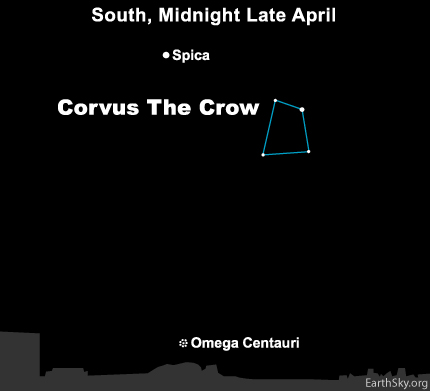Courtesy of EarthSky
A Clear Voice for Science
www.EarthSky.org

 Silvery-blue Spica, the only prominent star in the constellation Virgo, acts as your guide to the Omega Centauri globular star cluster. To the unaided eye, Omega Centauri looks like a fairly faint (and possibly fuzzy) star. Very few of the Milky Way galaxy’s 250 or so globular clusters are readily visible without optics.
Silvery-blue Spica, the only prominent star in the constellation Virgo, acts as your guide to the Omega Centauri globular star cluster. To the unaided eye, Omega Centauri looks like a fairly faint (and possibly fuzzy) star. Very few of the Milky Way galaxy’s 250 or so globular clusters are readily visible without optics.
To find Spica, extend the curve of the Big Dipper handle, as illustrated on our April 4 EarthSky Tonight. Spica transits – climbs to its highest point in the sky – around midnight tonight. Spica’s precise transit time for your sky is available at the US Naval Observatory. Spica – like any star – transits 4 minutes earlier with each passing night.
As seen from mid-northern latitudes, Spica and Omega Centauri transit due south in concert. Look for Omega Centauri about 35 degrees directly below Spica. (A fist at an arm-length approximates 10 degrees.)
People living south of 35 degrees north latitude have a realistic chance of spotting Omega Centauri, though it’s been seen as far north as Point Pelee, Canada (42 degrees north). Best appreciated with a telescope, Omega Centauri, the largest and brightest of all globular star clusters, is a globe-shaped stellar city, teeming with millions of stars!
Related:
Omega Centauri: Largest and brightest star cluster
Written by Bruce McClure
Other Links:
Astronomy Picture of the Day from NASA/JPL
U.S. Naval Observator Astronomical Information center
The York County Astronomical Society
 Print This Post
Print This Post








